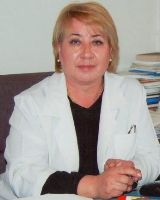Chief Editor
Vol. 4 No. 4 (2020): VESTNIK of KSMA
Full Issue
INTERNAL MEDICINE
-
ANALYSIS OF CLINICAL AND LABORATORY PARAMETERS OF SEVERE FORMS OF ACUTE INTESTINAL INFECTIONS IN ADULTS
AbstractSummary. This article contains results of exploration clinical laboratory indicators of 23 adult patients with severe form acute intestinal infection based on RCIH intensive care units’ materials for 2019. Presented criterion of evaluation of severity of illness, predictive criterials developing lifethreatening condition. 47.8% cases are patients 19-40 yers old, with chronic pathology of gastrointestinal tract, endocrine, cardiovascular with acute course of the illness during day (56.5%), mostly course of the disease was type gastroenteritis. Mostly patients have fever (60%), repeated vomiting (87%), diarrhoea with frequency of stools more than 5-10 time in day (65.2%), development of hypovolemic shock signs (52.2%). Procalcitonin as marker of bacterial infection was exceeded in 56.5% cases. Hypomagnesemia (78.2%), hyponatremia and hypokalemia (30.4%), increased creatinine (91.3%) and urea (43.4%) require timely correction of water-electrolyte balance.
-
TREATMENT OF CANDICAL BALANOPOSTHITIS
AbstractSummary. There are the results of clinical research and treatment of 62 patients with candical balanoposthitis in the article. After the complex treatment with systemic drug fruconasol (Mikoflu) in combined with the local therapy with combined ointment Akriderm GK 90.6% of patients had clinical and mycological recovery on 14th day from the start of treatment.
QUESTIONS OF SURGERY
-
RESULTS OF TREATMENT OF TRAUMATIC BRAIN INJURY AND ITS COMPLICATIONS
AbstractThere are 109 males (85.8%) among examined and 18 females (14.2%) in this study. Age of injured patients ranged from 17 to 82 years. Median age was 42.4±5.6 years. Of the 127 patients with severe traumatic brain injury, 8 died after being admitted to the hospital. General mortality was 6.3%.
-
CORRELATION OF CLINICAL AND NEUROIMAGING DATA IN SEVERE TRAUMATIC BRAIN INJURY
AbstractIt was analyzed clinical data and results of management in 128 series with acute stage of Skull Brain injury. Patients age varied from 16 to 85 years, 69 of them underwent surgery. All patients admitted with deep disturbances of consciousness: in spoor 17 patients (7-9 scores according to the Glasgow coma scale), in coma of 1-2nd grade 67 patients and in coma of 2-3rd grade 42 patients (305 scores according to the Glasgow coma scale). The Brain contusion of diQerent location was diagnosed in all patients.
-
DYNAMICS OF GROWTH OF APPENDICULAR PERITONITIS AT CHILDREN AND THE RESULTS OF ITS TREATMENT
AbstractResume. The article analyzes the frequency of surgical interventions for acute appendicitis and complicated forms. The use of glove drainage in the complex treatment of appendicular peritonitis improves end results in the early and late postoperative period in children.
-
INTRAOPERATIVE MEASURES FOR THE PREVENTION OF THE RECURRENCE OF LIVER ECHINOCOCCOSIS
AbstractSummary. The results of decontamination of fertile elements of echinococcus cyst contents in 173 patients with antiseptic dexane 0.02% with an exposure of 4-5 minutes and the drug introduction into a (brous capsule and pericapsular liver tissue during organ-sparing operations in order to prevent recurrence of the disease and in2ammatory processes of residual cavities with complicated forms of echinococcosis. A complication and recurrence of the disease in the post-operative observation did not occur.
-
DRAINING TECHNIQUES AND TORACOTOMY FOR THORACAL INJURIES (LITERATURE REVIEW)
AbstractIn the ɴrst four decades of a person’s life, injuries are the leading cause of death. However, chest injuries rarely require invasive procedures. In particular, the installation of pleural drainage is necessary in cases of violation of pleural integrity, causing hemothorax, pneumothorax or hemopneumothorax. Although traditional pleural drains have traditionally been used in hemothorax, recent data have challenged this technique,
demonstrating good performance on small diameter drains and Pigtail catheters. Although pleural drainage is a routine surgical procedure, training and practical experience are essential to avoid complications, even fatal ones. Surgical revision for chest injuries is performed quite rarely, accounting for less than 3%. Surgical revision is more likely for penetrating wounds than for blunt injuries. In these cases, anterolateral thoracotomy is performed, less often - surgical approaches such as «clamshell» or «semi-folding». Minimally invasive techniques can be used in selected patients. Large
randomized trials are still needed to evaluate and standardize new techniques for chest trauma. -
RESULTS OF SURGICAL TREATMENT OF POST-BURNS ESOPHAGEAL SCAR STRUCTURE
AbstractAbstract. The results and analysis of surgical treatment of post-burn cicatricial strictures of the esophagus in 12 patients with the NHC of the Ministry of Health of the Kyrgyz Republic were studied. 7 patients underwent retrosternal esophagocololoanas-tomosis, four patients underwent extirpation of the esophagus with complete replacement of the posterior mediastinum and esophagogastroanastomosis, and one patient was subjected to pharyngocologastroanastomosis.
QUESTIONS OF FORENSIC ACTIVITIES
-
THE SUDDEN DEATH AT A YOUNG AGE. THE ROLE OF CEREBROVASCULAR PATHOLOGY IN THE OCCURRENCE OF MASSIVE SUBARACHNOID HEMORRHAGES WITH A BREAKTHROUGH INTO THE SUBDURAL SPACE
AbstractSummary. An example of a forensic medical examination shows the role of a methodically correct forensic medical examination of a corpse and the use of forensic histological studies in solving the traumatic and non-traumatic genesis of massive subarachnoid hemorrhage with a breakthrough into the subdural space, as well as the role of cerebrovascular pathology in the onset of sudden death at a young age.
ANNIVERSARIES
-
TO THE 70-TH ANNIVERSARY OF PROFESSOR KUTTUBEK USENBAYEVICH AKYNBEKOV
AbstractAnnotation. This article is dedicated to the outstanding scientist, teacher and organizer of health care of the Kyrgyz Republic, Doctor of Medical Sciences, Professor K.U. Akinbekov. The article re騵ects the main stages of his activities, and also shows outstanding services to national education, science and health care.



